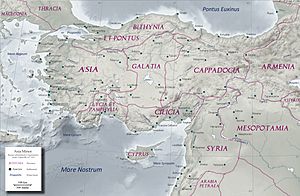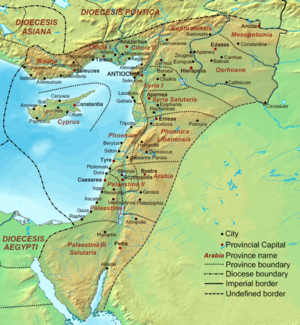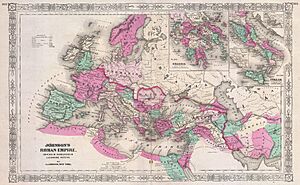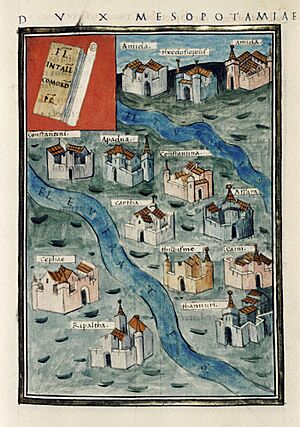Mesopotamia (Roman province) facts for kids
Quick facts for kids Provincia Mesopotamiaἐπαρχία Μεσοποταμίας |
|||||||||
|---|---|---|---|---|---|---|---|---|---|
| Province of the Roman Empire | |||||||||
| 116–117 198–637 |
|||||||||
 Provincia Mesopotamia within the Roman Empire. |
|||||||||
| Capital | Amida (Diyarbakır) / Dara (Oğuz) / Nisibis (Nusaybin) | ||||||||
| Historical era | Antiquity | ||||||||
|
• Established by Trajan
|
116 | ||||||||
|
• Evacuated by Hadrian
|
117 | ||||||||
|
• Re-established by Septimius Severus
|
198 | ||||||||
| 637 | |||||||||
|
|||||||||
| Today part of | Iraq Turkey Syria |
||||||||
Mesopotamia was a Roman province. It was first created by the Roman emperor Trajan around 116 AD. But it only lasted for a short time. Later, Emperor Septimius Severus brought it back in 198 AD. This land was often a battleground between the Roman Empire and the Sassanian Empire. It remained a Roman province until the Muslim armies took control in the 600s.
Contents
Trajan's Short-Lived Province
In 113 AD, the Roman emperor Trajan (who ruled from 98 to 117 AD) started a war. He fought against the Parthian Empire, a big rival in the east. In 114 AD, Trajan conquered Armenia. This area then became a Roman province.
By the end of 115 AD, he had also conquered northern Mesopotamia. This land was made into a province in early 116 AD. Coins were even made to celebrate this new conquest.
Later that year, Trajan marched further into central and southern Mesopotamia. He made the province of Mesopotamia even bigger. He also crossed the Tigris river into a place called Adiabene. This area became another Roman province, Assyria. Trajan even captured the Persian city of Susa. He put his own ruler, Parthamaspates, in charge of the Parthian throne. The Roman Empire never reached so far east again.
However, when Trajan died, his successor Hadrian (who ruled from 117 to 138 AD) gave up these new lands. All the areas east of the Euphrates river were returned. The Euphrates river then became the eastern border of the Roman Empire once more.
Severus Brings Mesopotamia Back
Lucius Verus and Roman Control
Northern Mesopotamia, including Osroene, came back under Roman control. This happened during the campaign led by Lucius Verus from 161 to 166 AD. These areas were not officially made into provinces yet. Instead, they were left under local rulers who worked with Rome. Roman soldiers were still stationed there, especially in Nisibis.
Civil War and Rebellions
Roman control was challenged in 195 AD. This was during a civil war between Septimius Severus (who ruled from 193 to 211 AD) and another leader named Pescennius Niger. Rebellions broke out in Mesopotamia, and Nisibis was attacked. Severus quickly brought peace back to the area. He then made Osroene a full Roman province.
Severus's Reconquest and New Province
Next, Severus started a war against the Parthian Empire. He won this war by attacking and taking their capital city, Ctesiphon, in 198 AD. Like Trajan before him, Severus decided to bring back the province of Mesopotamia in 198 AD. He made Nisibis its capital city. Nisibis was given the special status of a full colonia, which was like a Roman colony.
Trajan's old province of Mesopotamia covered a very large area. It stretched between the Euphrates and Tigris rivers. But Severus's new province was smaller. It was located between the province of Osroene to the south. The Euphrates and Tigris rivers were to its north. The Chaboras river (which is now called Khabur) was to its east.
Constant Border Conflicts
For the rest of its history, the province of Mesopotamia was a disputed land. It was often fought over by the Romans and their eastern neighbors, the Persians. The province suffered greatly during the many Roman–Persian Wars.
Around 239–243 AD, Ardashir I (who ruled from 224 to 241 AD) attacked the area. He was the founder of the new Sassanid Empire, which had replaced the old Parthians. Ardashir took control of Mesopotamia. But a Roman general named Timesitheus took it back in the Battle of Resaena before he died in 243 AD.
In the 250s AD, the Persian king Shapur I (who ruled from about 240 to 270 AD) attacked Mesopotamia again. He fought with the Roman emperor Valerian (who ruled from 253 to 260 AD). Shapur even captured Valerian at Edessa in 260 AD. However, the next year, Odaenathus of Palmyra fought against Shapur. Shapur eventually had to retreat.
Changes Under Diocletian and Constantine
Later, under the emperors Diocletian (who ruled from 284 to 305 AD) and Constantine I (who ruled from 306 to 337 AD), the Roman Empire was reorganized. Mesopotamia became part of the Diocese of the East. This larger region was then part of an even bigger area called the praetorian prefecture of the East.
The cities of Nisibis and Singara were lost to the Persians in 363 AD. This happened after the Roman emperor Julian's failed Persian campaign. The capital of the province was then moved to Amida. The main military commander, called the dux Mesopotamiae, was based in Constantina. Other important cities in the province included Martyropolis and Kephas.
Later Roman and Early Byzantine Times
After the Roman forces faced problems in the Anastasian War (502–506 AD), the East Roman emperor Anastasius I (who ruled from 491 to 518 AD) built a new fortress. This fortress was called Dara. It was built to counter Nisibis and became the new base for the dux Mesopotamiae.
During the changes made by Emperor Justinian I (who ruled from 527 to 565 AD), the province was divided. The northern parts, including Martyropolis, went to a new province called Armenia IV. The rest of Mesopotamia was split into two areas. One area, south of the Tigris river, had its capital at Amida. The other area, called Tur Abdin, had its capital at Dara.
The province suffered a lot during the many wars with Persia in the 500s. In 573 AD, the Persians even captured Dara. But the East Romans got it back after a peace treaty in 591 AD. They lost it again to the Persians in the great war of 602–628. They got it back once more, but then lost the entire region permanently. This happened during the Muslim conquests between 633 and 640 AD.
See also





